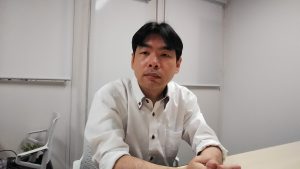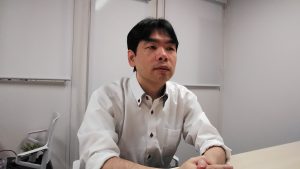
平田 秋彦
(ヒラタ アキヒコ)
教授/博士(工学)
材料科学専攻では、物質科学、数理科学、機械科学を融合させ、従来の枠を超えた革新的なアプローチで、材料科学の新たな地平を切り拓くことを目指しており、これにより持続可能な社会のための次世代材料を創出します。学問の深化とともに、実社会で活躍できる人材を育成することを目標としています。
早稲田大学の材料科学専攻は、これまでの早稲田における材料の教育および研究の伝統に基づき、2019年4月に新設されました。この新たな専攻の特徴は、物質科学、機械科学、数理科学の三つの融合した視点から材料科学を探求するところにあります。特に、必修科目である「材料の数理モデリング特論」を中心に、熱力学、結晶学、構造力学などの基本原理の習得を基礎としたカリキュラムにより、学生は物質の振舞いを数理的な視点から理解し、その知識を実材料の開発に応用する力を養います。また、研究においても融合的な視点や手法を取り入れることにより、学生は材料科学の最先端分野において活躍する能力を身につけることができます。
本専攻では、我が国の基幹産業の発展に必要となる材料科学の基礎および応用研究を目指しています。また、従来の学問体系に加え、数理的な視点や次世代材料に関わる視点を加え、次世代基幹産業分野での研究開発に関わる人材を育成・排出することを目指しております。本専攻の研究指導や講義を通じて、学生は、数理的な思考、多角的な視野、新たな手法開拓のような進取の精神などを身につけ、それらを基幹材料産業に応用する力を養うことができます。また、修了生は、鉄鋼など材料系産業から種々の基幹産業、さらには研究機関まで、多岐にわたる分野で活躍することが期待されています。学生には、異分野との協働を通じて柔軟な発想と対応力を身につけ、新たな価値を創造できる力を養ってほしいと考えています。
私の専門は、アモルファス材料の原子レベルでの構造やダイナミクスの研究です。このような材料では、周期的な原子配列を持つ結晶材料とは異なり、原子配列が乱れたものになっています。一見デタラメのように見えるのですが、その中にある秩序を見出すことを目標の一つとしています。我々は、先端計測、計算機シミュレーション、そして数理解析を組み合わせることにより、このような乱れた構造を理解し、材料としての特性の発現機構を明らかにしたいと考えています。中でも、数理解析として計算トポロジーと呼ばれる手法を使っています。トポロジーは柔らかい幾何学とも呼ばれ、物体が連続的に変形可能かという視点で研究を行う学問です。アモルファス材料のように規則正しい原子配列が無い場合でも、トポロジーを用いることで、隠れた秩序やパターンを見出すことが可能と考え、研究を進めています。研究の楽しさは新しい発見にありますが、その過程は決して簡単ではありません。しかし、自分の思いついたアイデアを色々な手法で確かめ、それで間違いないと思えたときの喜びは何物にも代えがたいものです。学生の皆さんにもぜひ研究の醍醐味を味わってもらえればと思っています。

材料科学専攻では、人類の持続的発展に不可欠な材料科学分野に対し、従来の学問に加え、数理科学や機械科学の視点を取り入れることで、新たな材料科学を作り上げていくことを目的としています。自然科学の探求が好きで、その成果が人類の発展に役立つことを望んでいるのであれば、本専攻は最適な場所となるでしょう。ぜひ、我々と一緒に新しい材料科学の創生に取り組みましょう。皆さまの入学を心よりお待ちしております。